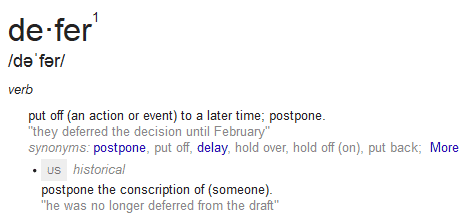What’s In Your Toolbox? (Part 3)
by Stephen Smalenberger, EA / April 4, 2017In the last blog entry What’s In Your Toolbox? (Part 2), we learned about the various types of taxable accounts and how the investment growth is taxed when earned.
Let’s turn our attention, today, to the next group of accounts in order to better understand the value these bring to our “toolbox” of options.
- Taxable
- Tax-Deferred
- Tax-Free
Even if you do not know it, you are probably more familiar with the concept of deferring taxes than you realize.
The Merriam-Webster dictionary defines the word “defer” to mean: put off or delay

And when we use a tax-deferred account as designed, that is exactly what we are doing. We are taking the recognition of any investment growth and putting it off, delaying or even postponing the taxability until a later time.
It is in the future, at that later point in time when money is pulled from the account(s), that the taxes are then incurred. This deferral could be a short period of time like a few months or a much longer period such as years or even decades.
While the tax treatment is the same across this entire group, the term “qualified” refers specifically to the 401(k), 403(b) or TSP which are employer-sponsored retirement plans. Meaning, you would only be able to participate in one of these tax-advantaged accounts as an employee in a corporation, a tax-exempt organization (schools, universities, hospitals or churches) or a government agency.
- Corporation: 401(k)
- Tax-Exempt Organization: 403(b)
- Government: TSP
While the IRA is technically a “non-qualified” account since “qualified” again refers to employer-sponsored or provided, it does experience the same tax treatment.
Deposit
The funding of the tax-deferred accounts is done on a pre-tax basis.
Money deposited into a Traditional IRA is known as a “contribution.” It is subject to the annual contribution limits based upon both age and earned income. Whether the contribution(s) may be eligible for a deduction on your tax return will depend upon whether or not you also participate in an employer-sponsored retirement plan at work and your overall income level. If you’d like to read more about this, please see an article I wrote called Can I Change My Tax Outcome After Year-End?
Money deposited into a 401(k), 403(b) or a TSP is done through something called “payroll deferrals.” In this case, you as the employee will elect to have your employer deduct a specified amount or a percentage of your paycheck and have that amount deposited into an account on your behalf.
A main difference from the taxable accounts is that there are now annual limits on the amount of money that can be deposited. This is true whether you are employed or self-employed. And being retired does not allow you this funding option any longer.
Although there are no age-based restrictions, an account can be opened and funded for those who have earned income or are the spouse of one who does.
Investment Growth
The money within these accounts may be invested in the market into such things as stocks, bonds, mutual funds and ETFs. As the underlying investments grow, so does the account.
The nature of the growth such as interest, dividends or capital gains/losses is no longer relevant since taxes will not be incurred until money is taken from the account also known as “withdrawals” or “distributions.”
A tax-deferred account incurs tax on the growth in the year withdrawn, not when earned.
Withdrawals
Unlike a taxable account like a checking, savings or an investment account which we can liquidate at any point in time, there are some specific rules that need to be followed with the tax-deferred. For the purposes of this blog, I will not go into the detail of the various rules, but wanted to make you aware that they exist.
A main theme to remember is that the reason these accounts enjoy their tax-advantage nature is because they are designed for retirement. Each area of the Tax Code was intentionally written to encourage or create an incentive for certain behavior(s) of American citizens.
In this case, we are encouraged to save for retirement and to hopefully not need to access these funds until at least 59 ½ years old. And while the accounts provided us with a tax benefit and then grew tax-deferred, the Government needs to earn its tax revenue at some point which is currently 70 ½ when Required Minimum Distributions start.
Here’s a summary of what we have covered so far:
| Taxable | Tax-Deferred | Tax-Free | |
|---|---|---|---|
| Can anyone set up an account? | Yes | No | |
| Deposit limits? | No Limit | Yes | |
| When is the account taxed? | As Earned | When Withdrawn | |
| Withdrawal restrictions? | No | Yes |
Please stay tuned for the last few posts of this series as we learn about the tax-free accounts and then how to choose the right “tool” for the job.
Ready to take the next step?
Schedule a quick call with our financial advisors.
Recommended Reading
Strategies for Restricted Stock Unit Taxes [Video]
In this video, we breakdown the types of RSU vesting schedules and different strategies for handling Restricted Stock Unit taxes.
Strategies for Early Retirement Healthcare [Video]
Early retirement healthcare can be tricky. This video explains your health insurance options before age 65 and Medicare.

Stephen Smalenberger, EA
Steve enjoys getting to know clients and hear their unique stories and the lessons learned which has brought them where they are today. One of the reasons he enjoys what he does is the ability to show the outcome that can be achieved with different choices. He also enjoys continually learning.

